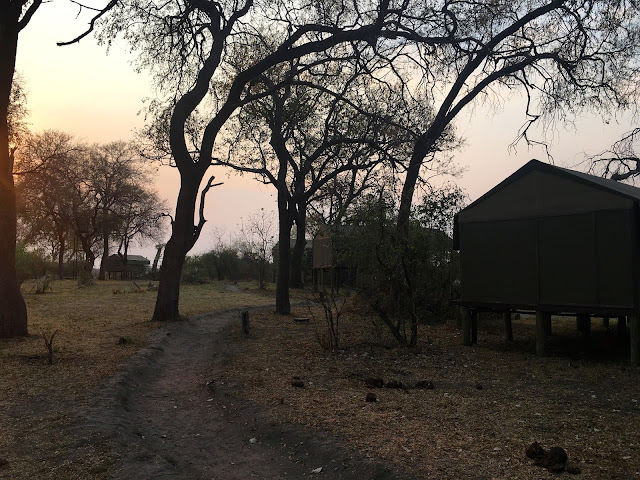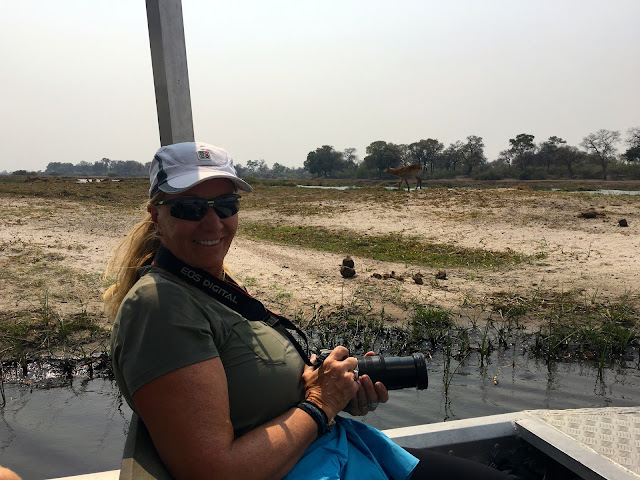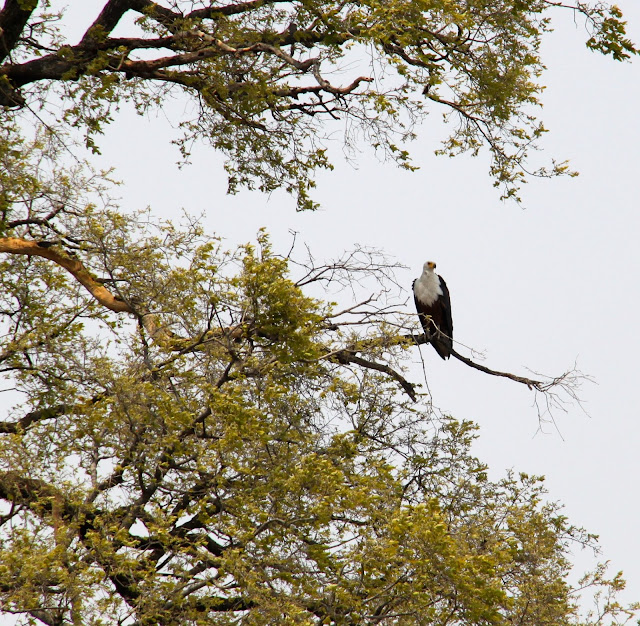The Zambezi Region of Namibia
Camp 2
Nkasa Lupala
The lodge is in the Nkasa Lupala National Park.
We drove in our trusty Land Rover named Chuma, with it's amazing altered seat to fit Scott. We passed many villages and interesting sites along the way. The women all balance things on their head when they walk, instead of carrying them. There were burnt pieces of wood for sale that they use for coal to burn their fires.
We had to cross the border from Zambia into Namibia. Going out of Zambia was easy, but getting into Namibia was a huge line of locals trying to get across the border to do their shopping. After wandering around, trying to figure out what to do, Scott asked a guard where we go to register our car, and he let us in the front of the long line. Thank goodness!
The Caprivi Strip has been renamed the Zambezi Region. This area is in the northeast region of Namibia and borders Botswana. The border is defined by the Linyanti, Chobe, and Kwando River. It is the same river with three different names, which denote the area of the river. We visited two tented safari camps in this area.
The first camp is the Nkasa Lupala tented camp. We drove 11 kilometers through very deep sand to get to it. This will probably be the most primitive camp that we will visit. Everything is run on solar power. Our tent was very hot during the day, and no fan.
The night we arrived we went on a night safari using a big spotlight to look for the shining eyes of the animals. For the first hour of the drive we joked that we were finding the smallest five animals in Africa. To my delight we first found the elusive Duiker. This is a very small antelope that is active at night. We have had fun with the Duiker ever since we spotted one in South Africa with the kids. We have fun calling our kids a “Durker”.
The next animals we saw were a White Tailed Mongoose, a Serval Cat, and quite a few Spring Hares. All these animals are very small.
We then saw lots of Hippos out of the water and grazing. They walk and eat grass all night and then get back into the water during the day. They follow the same paths night after night (Hippo highways). They can run 40 kilometers per hour and would be very difficult to out run. If they are running straight for you our guide said that you can simply step five feet to the side and they will run straight past you. They will not chase you like a rodeo bull would chase a cowboy.
The next morning we drove to the Linyanti River spotting Elephants, the Greater Kudu, Water buck, Reed Buck, and Impala along the way.
We got into a small boat at the Linyanti and motored slowly past many pods of Hippos since they are very dangerous if they are provoked. We saw maybe 100 Elephants coming down to the river to drink and roll in the mud.
We saw many different birds.
Having a great time!
Off to our next camp.
Camp 2
Nkasa Lupala
The lodge is in the Nkasa Lupala National Park.
 |
| Nkasa Lupala Lodge |
 |
| Our home on stilts |
 |
| Camp area |
 |
| Scott now has so much leg room, he can put his knee up |
 |
| A village along the way |
 |
| Coal for sale along the road |
 |
| Home with a fenced area for animals |
 |
| Pit stop for Chuma |
 |
| Donkey carts |
 |
| The roads are so dangerous with bad potholes. The is a large truck on it's side after hitting a pothole. |
 |
| Local Nordstrom |
 |
| Carrying kids, brothers, and dinner? |
 |
| I'll just carry this rug home |
 |
| Crossing one of three bridges to the camp |
 |
| The better part of the sandy roads |
We had to cross the border from Zambia into Namibia. Going out of Zambia was easy, but getting into Namibia was a huge line of locals trying to get across the border to do their shopping. After wandering around, trying to figure out what to do, Scott asked a guard where we go to register our car, and he let us in the front of the long line. Thank goodness!
 |
| Barb at the border |
The first camp is the Nkasa Lupala tented camp. We drove 11 kilometers through very deep sand to get to it. This will probably be the most primitive camp that we will visit. Everything is run on solar power. Our tent was very hot during the day, and no fan.
 |
| Our humble abode |
 |
| Scott at the main camp |
 |
| Walking home after a dip in the 3 foot pool |
The night we arrived we went on a night safari using a big spotlight to look for the shining eyes of the animals. For the first hour of the drive we joked that we were finding the smallest five animals in Africa. To my delight we first found the elusive Duiker. This is a very small antelope that is active at night. We have had fun with the Duiker ever since we spotted one in South Africa with the kids. We have fun calling our kids a “Durker”.
 |
| Diuker (Durker) |
The next animals we saw were a White Tailed Mongoose, a Serval Cat, and quite a few Spring Hares. All these animals are very small.
We then saw lots of Hippos out of the water and grazing. They walk and eat grass all night and then get back into the water during the day. They follow the same paths night after night (Hippo highways). They can run 40 kilometers per hour and would be very difficult to out run. If they are running straight for you our guide said that you can simply step five feet to the side and they will run straight past you. They will not chase you like a rodeo bull would chase a cowboy.
 |
| Hippo's come out of the water at night to feed. They can walk 5 or 6 kilometers at night. They also run very fast. |
 |
| Hippo in the water |
 |
| Hippo's are very territorial and very dangerous |
The next morning we drove to the Linyanti River spotting Elephants, the Greater Kudu, Water buck, Reed Buck, and Impala along the way.
 |
| Wart hogs |
 |
| Greater Kudu |
 |
| Impala |
 |
| Bushbuck |
 |
| Oryx |
We got into a small boat at the Linyanti and motored slowly past many pods of Hippos since they are very dangerous if they are provoked. We saw maybe 100 Elephants coming down to the river to drink and roll in the mud.
 |
| Barb on the river boat |
 |
| Scott with 2 elephants |
 |
| Lots of elephants |
 |
| The herd is very protective of all the babies |
We saw many different birds.
 |
| Tawny Eagle |
 e e |
| Fish Eagle |
Having a great time!
Off to our next camp.













No comments:
Post a Comment